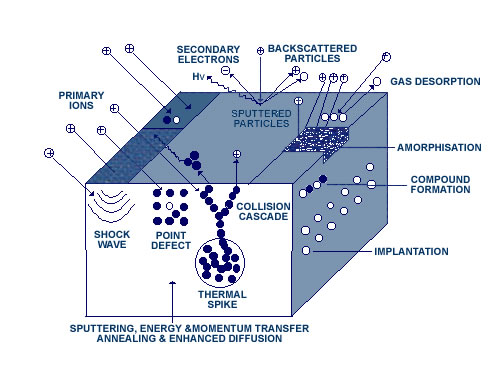This page focuses on the magnetron sputtering PVD vacuum surface coating method as it is the most used PVD thin film coating method due to its suitability for a variety of applications. However, if you click the links, you can see the fundamentals of arc evaporation and pulsed laser ablation.
What is the surface coating technique magnetron sputtering?
A coating method as versatile as magnetron sputtering can be utilised to cover almost any material. Sputtering is essentially the energetic bombardment of a solid’s surface layers by ions or neutral particles in order to remove atomized material from it.
Magnetron sputtering – A vacuum coating process
A vacuum of less than one ten millionth of an atmosphere must be attained prior to the sputtering coating procedure. A controlled flow of an inert gas, such as argon, is added once the proper pressure has been established. In spite of the fact that it is still only a few ten thousandth of atmospheric pressure, this increases the pressure to the bare minimum required to activate the magnetrons.
Magnetron sputtering – The sputtering process
A negative voltage of generally -300V or more is provided to the target when power is given to a magnetron. Positive ions are quickly drawn to the target surface by this negative voltage. Usually, energy is transferred when a positive ion strikes atoms near the surface of a solid. Primary recoil atoms can be produced if the energy delivered to a lattice site is more than the binding energy. These atoms can collide with other atoms and disperse their energy through collision cascades. If the energy transmitted to a surface atom normal to the surface is greater than approximately three times the surface binding energy (roughly equivalent to the heat of sublimation), the atom will become sputtered.
The sputtering of a target atom
Magnetron sputtering – Sputtering is only one result of ion bombardment
One of the outcomes of ion bombarding a surface is the sputtering of a target atom. The remaining options are outlined below. The emission of secondary electrons from the target surface follows sputtering as the second crucial process. The sustainment of the glow discharge is made possible by these secondary electrons.
Magnetron sputtering – Almost no restriction on target material
The target materials for the sputter process are essentially unrestricted, ranging from pure metals, which can be powered by a d.c. power supply, to semiconductors and isolators, which need an r.f. power supply or pulsed dc. Deposition can be done using reactive or non-reactive discharges with single or multiple element targets (inert gas only or both).
Magnetron sputtering – Magnets enable lower pressures to be used
A magnetic field can be utilised to confine secondary electrons near the target during the sputtering process. In contrast to what would normally happen, the electrons take helical courses around the magnetic field lines and experience more ionising collisions with neutral gaseous materials close to the target. This increases the plasma’s ionisation close to the target, increasing the sputter rate. Additionally, it indicates that a lower pressure can keep the plasma stable. Since the sputtered atoms are neutrally charged, the magnetic trap has no effect on them.
The movement of an electron around a magnetic field line
The technical name for this vital invention is the magnetron. Click magnetron to learn more.
To find out how coatings grow on a surface click nucleation and growth.


